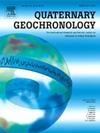上莱茵地堑北部晚新生代河流沉积物的多方法发光测年
IF 2.5
2区 地球科学
Q3 GEOGRAPHY, PHYSICAL
引用次数: 0
摘要
上莱茵河地堑(URG)包含中欧最连续的上新世-更新世松散沉积物序列之一。为了了解莱茵河河系沉积和侵蚀过程的驱动因素以及第四纪及以后裂谷系的地质演化,沉积物的数值定年是必不可少的。2020年和2021年,黑森州自然保护、环境和地质局(HLNUG)在德国黑森州Riedstadt-Erfelden附近开展了一个新的大陆钻探项目,以获取有关URG北部开发的进一步信息。在这里,我们提出了来自岩心上部样品的多方法发光测年方法的地质年代信息。石英的光激发发光(OSL)和k长石的红外辐射荧光(IR-RF)的初步结果与红外激发发光(IRSL)、后红外激发发光(pIRIR)和红外光致发光(IRPL)的新测量结果相辅相成。后者是一种相对新颖的方法,使用了来自钾长石的潜在非衰落和非破坏性信号。我们首次在河流样品上应用了多重高温(MET)- piril -IRPL单等分再生剂量(SAR)方案,并给出了该方案产生的IRSL和IRPL信号的衰落率。我们发现,IRPL年龄与以往研究的中更新世发光年龄和生物地层资料基本一致,而衰减可以忽略不计,对不同试验剂量的敏感性较低。OSL年龄可达~ 65 ka,与早期研究中报道的沉积相匹配。虽然IRPL和IR-RF年龄被认为是由相同的剂量陷阱产生的,但从两种信号中观察到的年龄差异可能是由于灵敏度校正方法的差异,尽管我们注意到,随着信号接近饱和,两种方法的年龄会收敛(>200 ka)。pIRIR225和pIRIR290的年龄普遍高估了OSL和IRPL的年龄。由于IRSL50年龄仍然低估了石英年龄,因此衰落校正并不成功。研究结果表明,曼海姆组为elsterian - holsteian (MIS 12-11) -晚期Weichselian (MIS 2)沉积期,路德维希港组为Cromerian (MIS 13-21)沉积期。本文章由计算机程序翻译,如有差异,请以英文原文为准。
Multi-method luminescence dating of late Cenozoic northern Upper Rhine Graben fluvial sediments
The Upper Rhine Graben (URG) contains one of the most continuous sequences of unconsolidated Plio-Pleistocene sediments in central Europe. In order to understand the driving factors behind the sedimentation and erosion processes of the river Rhine fluvial system as well as the geological evolution of the rift system during the Quaternary and beyond, numerical dating of the sediments is indispensable. In 2020 and 2021, the Hessian State Agency for Nature Conservation, Environment and Geology (HLNUG) carried out a new continental drilling project near Riedstadt-Erfelden in Hesse, Germany, to obtain further information on the development of the northern part of the URG. Here, we present geochronological information derived from a multi-method luminescence dating approach of samples from the upper section of the core. Preliminary results from optically stimulated luminescence (OSL) of quartz and infrared-radiofluorescence (IR-RF) of K-feldspar are complemented by new measurements using infrared-stimulated luminescence (IRSL), post-infrared-IRSL (pIRIR) and infrared photoluminescence (IRPL). The latter is a relatively novel approach with the usage of a potentially non-fading and non-destructive signal from K-feldspar. For the first time, we apply a multiple elevated temperature (MET)-pIRIR-IRPL single aliquot regenerated dose (SAR) protocol on fluvial samples and present fading rates for the IRSL and IRPL signals derived from the protocol. We find that IRPL ages agree generally well with Middle Pleistocene luminescence ages of previous studies and biostratigraphic data while showing negligible fading and less sensitivity to a varying test dose. OSL ages up to ∼65 ka match phases of aggradation reported in earlier studies. Although IRPL and IR-RF ages are thought to arise from the same dosimetric trap, discrepancies in ages observed from both signals could be due to the required difference in sensitivity correction methods, though we note that as the signals approach saturation, the ages from both methods converge (>200 ka). The pIRIR225 and pIRIR290 ages generally overestimate OSL and IRPL ages. Fading correction of IRSL50 ages was not successful as they still underestimate quartz ages. Our results indicate an Elsterian-Holsteinian (MIS 12-11) to late Weichselian (MIS 2) age of the Mannheim formation and a Cromerian (MIS 13–21) deposition of the Ludwigshafen formation.
求助全文
通过发布文献求助,成功后即可免费获取论文全文。
去求助
来源期刊

Quaternary Geochronology
地学-地球化学与地球物理
CiteScore
4.40
自引率
22.20%
发文量
130
审稿时长
20 weeks
期刊介绍:
Quaternary Geochronology is an international journal devoted to the publication of the highest-quality, peer-reviewed articles on all aspects of dating methods applicable to the Quaternary Period - the last 2.6 million years of Earth history. Reliable ages are fundamental to place changes in climates, landscapes, flora and fauna - including the evolution and ecological impact of humans - in their correct temporal sequence, and to understand the tempo and mode of geological and biological processes.
 求助内容:
求助内容: 应助结果提醒方式:
应助结果提醒方式:


